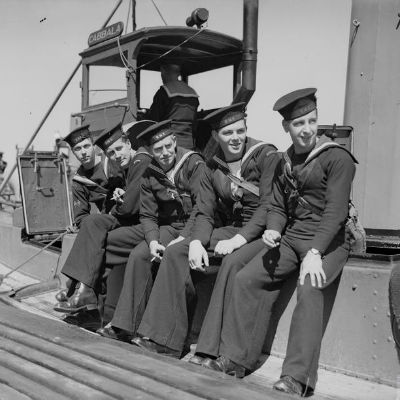Two civilian pressmen were among the photographers called up to witness the British Expeditionary Force in 1939 and 1940.
When the Second World War broke out in September 1939, just one Army photographer, Geoffrey Keating, and one cameraman, Harry Rignold, accompanied the British Expeditionary Force to France. On 24 October 1941, the Army agreed to form a corps of trained photographers and cameramen. The unit was called the Army Film and Photographic Unit (AFPU).
AFPU photographers and cameramen were recruited from the ranks of the Army. Many had been press photographers or cameramen in peacetime. All recruits had to undergo compulsory training in battle photography at Pinewood Film Studios. Badges and permits were issued after attempts to confiscate film by overzealous British soldiers.
The first AFPU section deployed to North Africa. More men were recruited and deployed to Syria, Palestine, Cyprus and Iraq. No. 2 Section covered the campaigns in Tunisia, Sicily and Italy.
On D-Day, 6 June 1944, ten AFPU men from newly formed No. 5 section accompanied the first wave of troops ashore, while others landed with airborne troops by parachute or glider. In the following months, the AFPU accompanied the British Army as it fought its way across Europe.
Despite the tough battles they had experienced, nothing prepared the AFPU for the scenes that they encountered at Bergen-Belsen concentration camp when they entered the camp on 15 April 1945. In vivid contrast, the AFPU covered the surrender of the German forces in Europe. Many then joined No. 9 Section to cover the ongoing war in the Far East. The AFPU disbanded in 1946.
First published by Amanda Mason on the Imperial War Museums website






'The Photographers of WW2' has 1 comment
10th February 2022 @ 2:56 pm Gord Harrison
I tip my hat to your recognition of the RN photographers, WWII. Brave men, their hundreds of 1000s of pictures reveal so much re the war. My father was caught unawares (perhaps) by one such photographer on the landing beaches near Arzeu during Operation Torch – invasion of North Africa – beginning Nov. 8, 1942. The photo of Canadian Doug Harrison (RCNVR, Combined Operations) appears in another of Brian Lavery’s books, ‘Assault Landing Craft: Design, Construction…’, pages 102-103. Members of the RN who entered Combined Operations is well-described in Lavery’s ‘Hostilities Only’, Chapter 17. I am associated somewhat w the Canadian texts concerning the same subject, i.e., the Canadian sailors who also volunteered for Comb. Ops. RN Photographers, e.g., Lt. F. A. Hudson in North Africa, have provided me with a great deal of valuable photos and insights into my father’s training and the operations he was subsequently involved with, from Dieppe Raid to Operation Baytown, invasion of Italy (beginning Sept. 3, 1943). Your website is very informative, I wish continued success. Gord H., London Ontario Canada